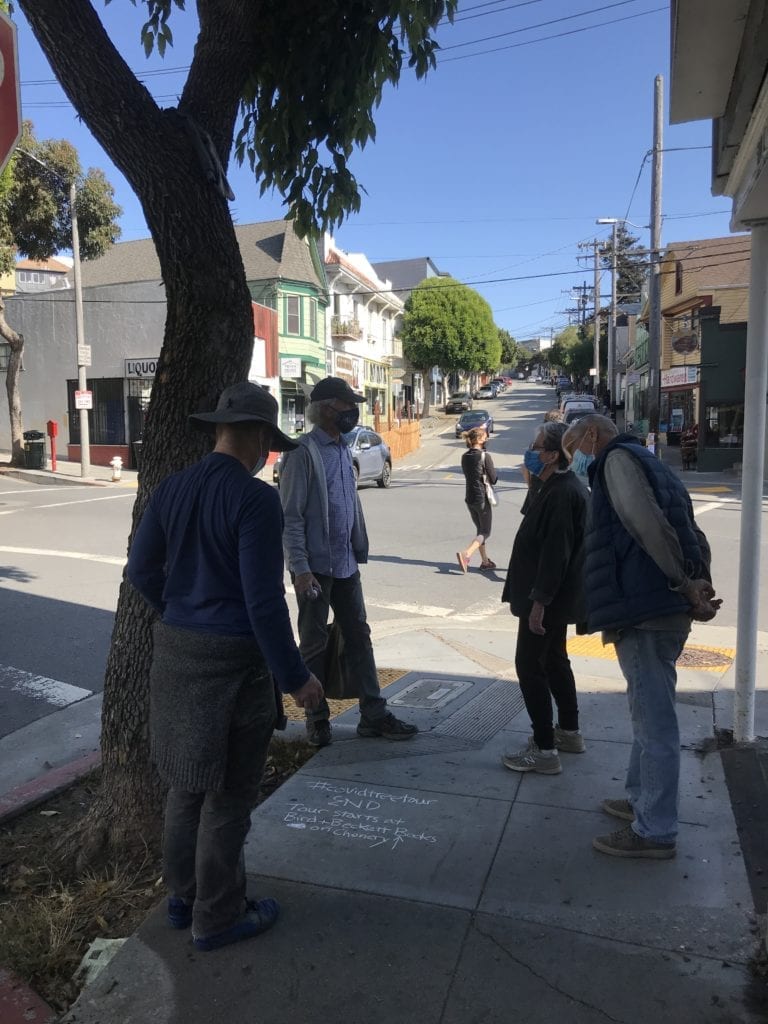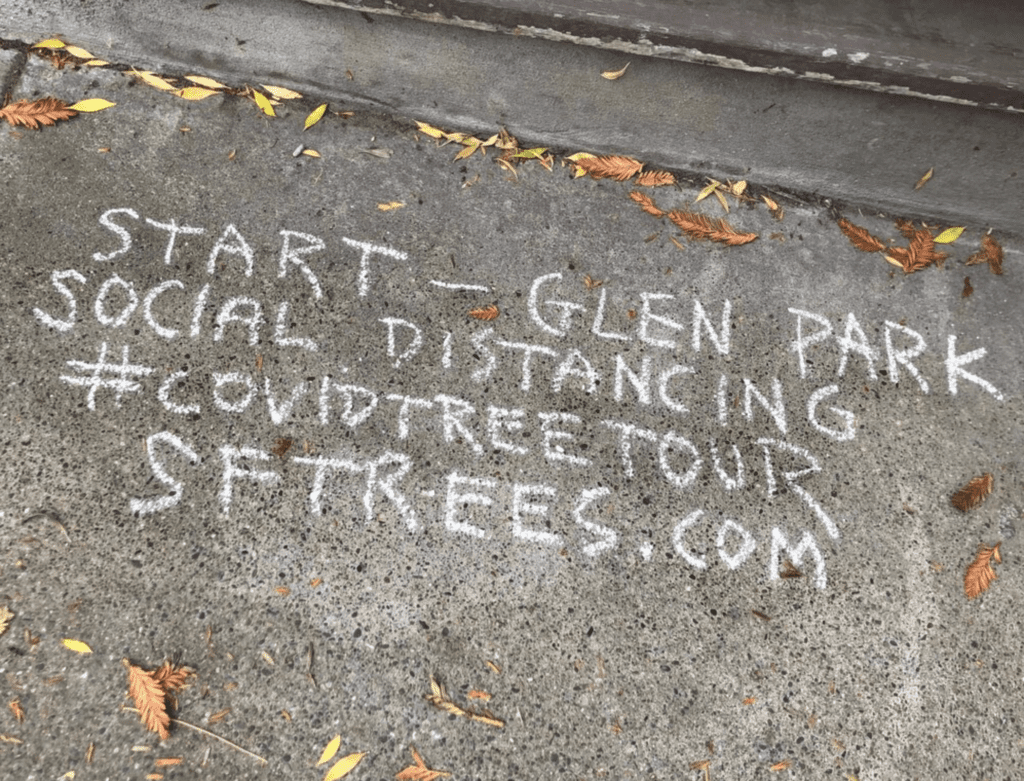
Glen Park neighbors have long experienced California wildflower walks through Glen Canyon Park along with spider walks, and then of course Glen Park Neighborhoods History Project history walks. But they have never encountered anything like what greeted them on Sunday morning, October 25, 2020.
Chalked on the sidewalk in front Bird & Beckett’s Books and Records on Chenery Street they read:
START – Glen Park Social Distancing #COVID Tree Tour SFTrees.com
The block lettering announced the first-ever Glen Park street tree ramble thanks to Kay Estey, Digging the Dirt columnist for the Glen Park News.
Find the full tour online here.
“My long-time friend Dick Turner told me about sftrees.com that highlights neighborhood tree tours and I logged on, loved it, and saw there was a blank spot for Glen Park,” said Estey, a 30-year resident of Conrad Street. “I said ‘That’s no good. I can think of two significant trees near my house.’ Do I asked Dick, ‘How can I help organize a tree walk around Glen Park?’”
Turner, who was editor for Pacific Horticulture for 20 years and is now retired, enlisted Mike Sullivan, author of Trees of San Francisco and Jason Dewees, author of Designing with Palms.
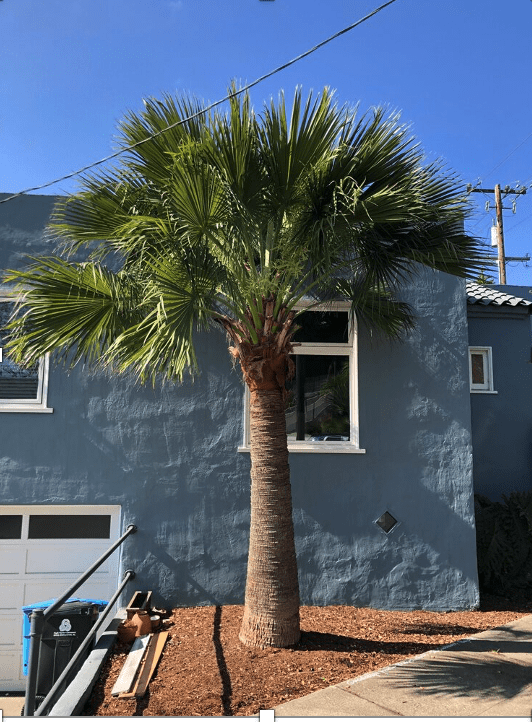
Since the inception of the pandemic, they have orchestrated nearly two dozen similar City tours.
“We’re like the Three Musketeers of trees,” said Turner.
Instead of brandishing swashbuckling rapiers, the horticultural wizards wield chalk and hairspray in the service of schooling Glen Park about the abundance of arbor adjacent to their front doors.
The men follow a six-month regimen “tagging” sidewalks. After scouting a neighborhood or following up a lead such as Kay Estey’s, the tree guys settle upon intriguing trees.
“Each tree gets chalked with three pieces of information on the sidewalk,” said Mike Sullivan. “Its common name, its scientific name and its geographic place of its origins. Sometimes we add tidbits such as the water gum of Australia is the most common tree in San Francisco.”
Chalk and hairspray, you wonder?
“Jason and I handle the description with white chalk,” Sullivan said, “and Dick brings blue chalk and gives the tree a number, then he grabs the hairspray, which acts as a fixative and sprays the chalk.”
Alas, nothing lasts forever, certainly not a chalked sidewalk.
“Once we’re done, Dick types up the notes, complete with street addresses and sends them to me,” Sullivan said. “I put them up on the website. That way when the chalk fades the tour will still be there.”
Turner usually gets the copy to webmaster Sullivan within a couple of days, it is put under Jason Dewees’s lens for precise arboriculture accuracy, then Sullivan typically gets the site updated in 24 hours.
The musketeers have been successful, touring Noe Valley, the Mission, Dogpatch, Bernal Heights, Potrero Hill, the Lower Haight, Sea Cliff, and the Inner Sunset. Westwood Park has recently been uploaded to their website and they haven’t had to dragoon D’Artagnan for backup.
Sullivan says he does the tours for many reasons. “In part, I’d like people to know and appreciate the trees that they pass by every day, in part, because it’s delightful hanging out with Dick and Jason, and, in part, because it’s fun to explore new a neighborhood every two weeks and make new discoveries.”

In his introduction to the Glen Park #COVID Tree Tour, Turner, the current editor of Trees of Golden Gate Park, nails the little neighborhood that could.
“Glen Park is one of the most charming and distinctive neighborhoods in San Francisco,” he penned. “Steep hills facing south, narrow winding streets, and jewel box homes characterize the neighborhood along with a good selection of trees. Combine that with a small but wonderful shopping district, and you’ve got a nearly perfect residential neighborhood.”
The three tree geeks, as they self-deprecatingly describe each other, were primed to begin their excursion on a warm Sunday morning. So, it was only fitting they start their stroll at Bird & Beckett, Glen Park’s iconic Chenery Street bookstore that Turner described in his introduction as “one of the most popular independent bookstores in town.”
“We want to make the tour a loop,” said Sullivan, “so no matter where you begin by the end you’re back near your start.”
With the Esteys in tow, they left bookseller Eric Whittington’s bibliographic gift to the neighborhood that keeps coming in their wake.
Mike Sullivan’s rubric for identifying a tree of interest is as simple as a carving a Halloween pumpkin or baking a Thanksgiving apple pie.
“It has to be large, it has to have a history and it has to make a good photo,” said Sullivan, who planted a Soapbark tree in 2004 in front of his Parnassus Heights house when his son was born.
With Destination Bakery across the street, the group stopped at 641 Chenery Street before another candidate for chalking.
It more than met muster.
Jason Dewees identified it, knelt and printed both Canary Island date palm and Phoenix canariensis, then Canary Islands/Spain on the sidewalk. Then Dick Turner anointed the inscription with the number 3 in blue.
“Jason’s truly encyclopedic in his knowledge,” said Sullivan, about Dewees, a horticulturist at Flora Grubb Gardens who lives in the Inner Richmond. “There’s literally no tree, no detail he doesn’t know.”
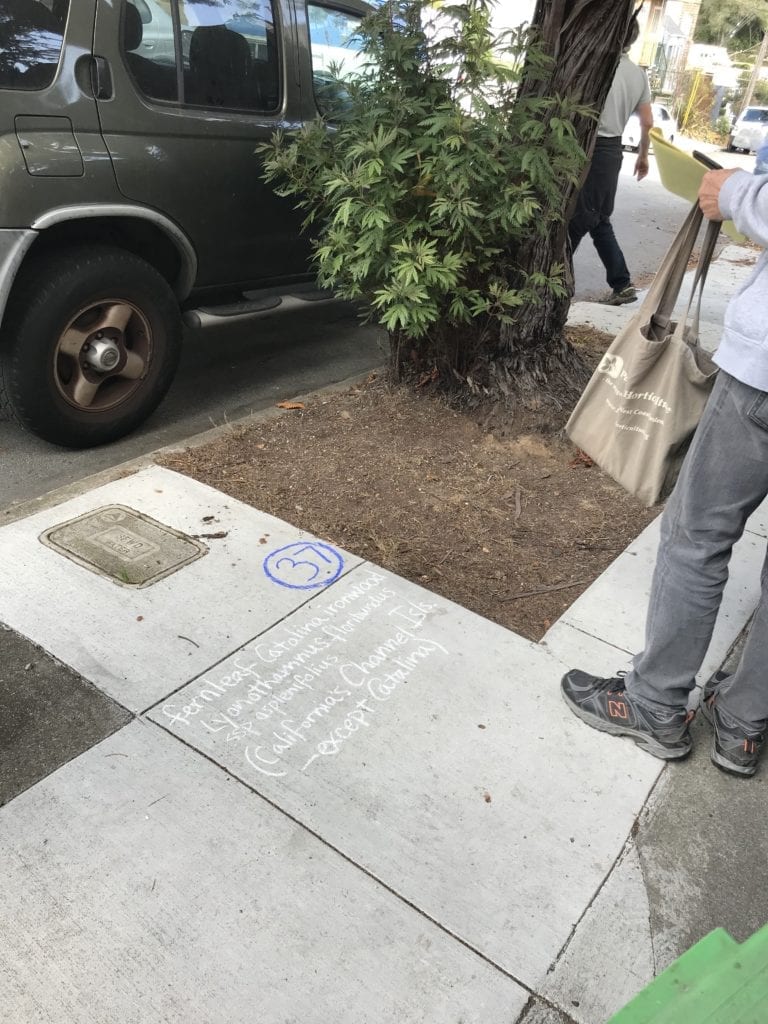
Canary Island palms line the medians of upper Market Street and Dolores Street, said Sullivan. “It’s one of the trees best adapted to our climate, but it’s under threat from a disease called fusilium wilt, which kills the tree once it is infected.”
Before finishing that morning, the three men would mark 56 street trees.
They took a left on Castro Street and headed to Laidley Street.
“We like to keep the walk to a little under two hours,” Turner said.
“And not too hilly,” said Sullivan, whose interest in the City’s some 600 street trees began in the early 1990s when he started volunteering with Friends of the Urban Forest, planting trees every Saturday with groups of neighbors all over the city. He later joined FUF board of directors and served for 12 years including a stint as its president.
Avoiding hills in Glen Park, though, which once billed itself as “Little Switzerland,” is no mean feat.
At Castro and Laidley Streets the quintet tuned right, walking a few blocks to Mateo Street before doubling back on the other side of Laidley, both sides of which held towering treasures.
Australian-born Kay Estey, who hails across the Tasman Sea from New Zealand, stood captivated in front of 554 Laidley Street.
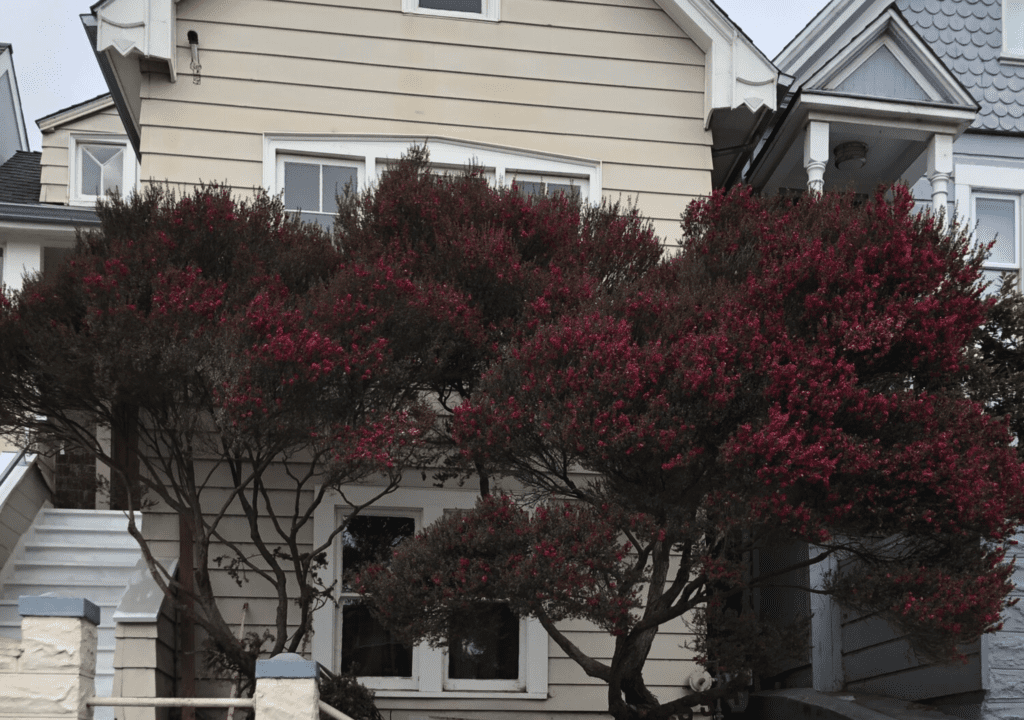
“These are called New Zealand tea trees,” the Melbourne-born San Franciscan said, “and are planted in Glen Park gardens as they tolerate coastal conditions and summer drought.”
While Dewees and Turner worked wonders with their calligraphy, Mike Sullivan added his own nugget. “Getting a tip from the Maori, Captain Cook used tea from its leaves to cure his sailors from scurvy when he visited New Zealand in 1769.”
“It is a compact shrub with dark leaves and oxblood red double blooms,” Estey said of the tree known as manuka on its home island. It is “admired for its swooping dramatic growth habits.”
Only a few doors away, with Glen Park Elementary School in view, another New Zealand import stood, as anemic as the manuka was healthy.
Mike Sullivan identified it as a Myoporum laetum, commonly known as the mousehole tree in its home nation. Listing in front of 535 Laidley Street, it appeared emaciated, its branches thinning, its trunk a perforation of blemishes.
“Poor Myoporum,” said Estey. “It’s under attack by thrips, a nasty little sucking insect that is slowly wiping out the species.”
“This tree used to be one the best-adapted trees to San Francisco – everyone one of them in perfect health until this pest showed up a few years ago.” Now almost all are under attack.
“There is no cure except to cut the tree to the ground,” concluded Estey, dotting the I and crossing the T to their colloquy. “It is considered invasive in California and the leaves are toxic to animals.”
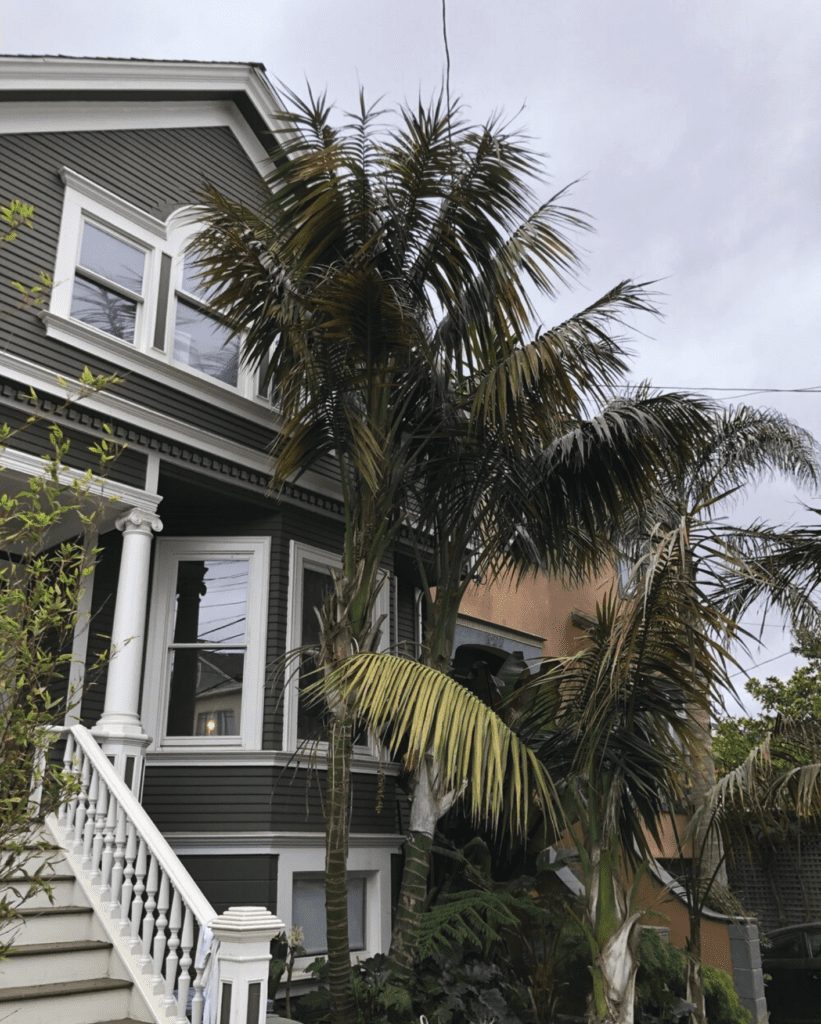
A couple of blocks away, in front of 371 Laidley, Estey perked up, allowing her eyes to roam over a group of palms, Kentia and queen palms, much like the Canary Island date palm that stood guard at 641 Chenery.
“I don’t think the popularity of palms ever wanes,” she enthused. “The neighbors on the block have planted a sophisticated selection of Kentia palms.”
Mike Sullivan was similarly impressed.
“The Kentia is a relatively rare palm for San Francisco. It’s native to tiny Lord Howe Island, off of Australia,” he said. Surveying the block, he continued. “When we planned the walk, this was our “destination” – we wanted to get to this little grove of interesting palm trees.”
With Sussex Street calling, the friends executed a dogleg up Roanoke Street. A cathedral of overarching branches, acting like leafy umbrellas, beckoned them up the hill that ended at Bemis Street.
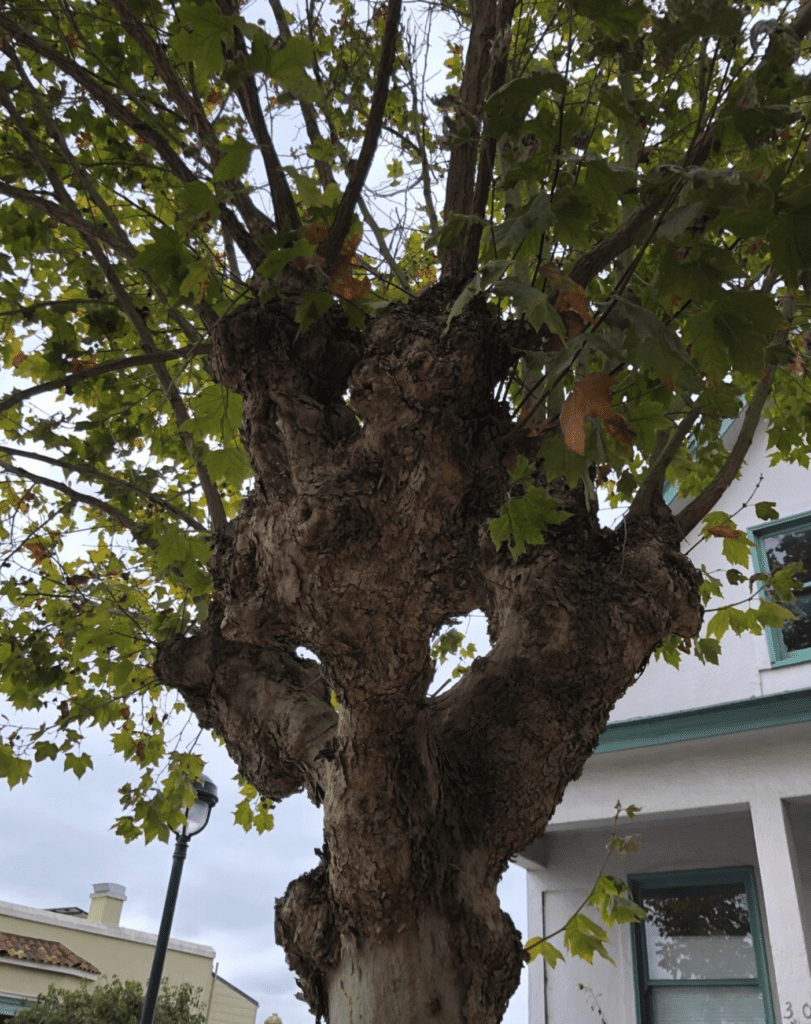
The detour paid foliage dividends.
“The entire block of Roanoke is planted with deciduous London plane trees,” said Estey, as she stood silhouetted beneath the canopy. “They were very popular in the early twentieth century, but they are a problematic tree. They are naturally huge and to prevent them from reaching their stature are often given an annual pruning that leaves the stumps to sprout shorter shoots in the next season. Their leaf drop is impressive in the fall and their roots can be invasive.”
Sidewalks buckling beneath Lovecraftian tangles or sewer pipes skewed by colonizing Medusa-like root systems do not go unnoticed by either Estey or Sullivan who both acknowledge the importance of street trees coexisting with City infrastructure.
“Friends of Urban Forests will gladly assist residents in determining which is the best tree to plant,” said Estey, a charter member of the Glen Park Garden Club, “ensuring the integrity of sidewalks and pipes.”
“And since StreetTreeSF, a city-wide street tree maintenance program was passed in 2016 and transferred responsibility for care and maintenance of the City’s street trees from property owners to Public Works,” she continued, “trees are inspected and pruned block-by-block on a regular basis.”
Public Works is aware and ready to control and provide guidance and is more than ready to go after sewer stranglers.
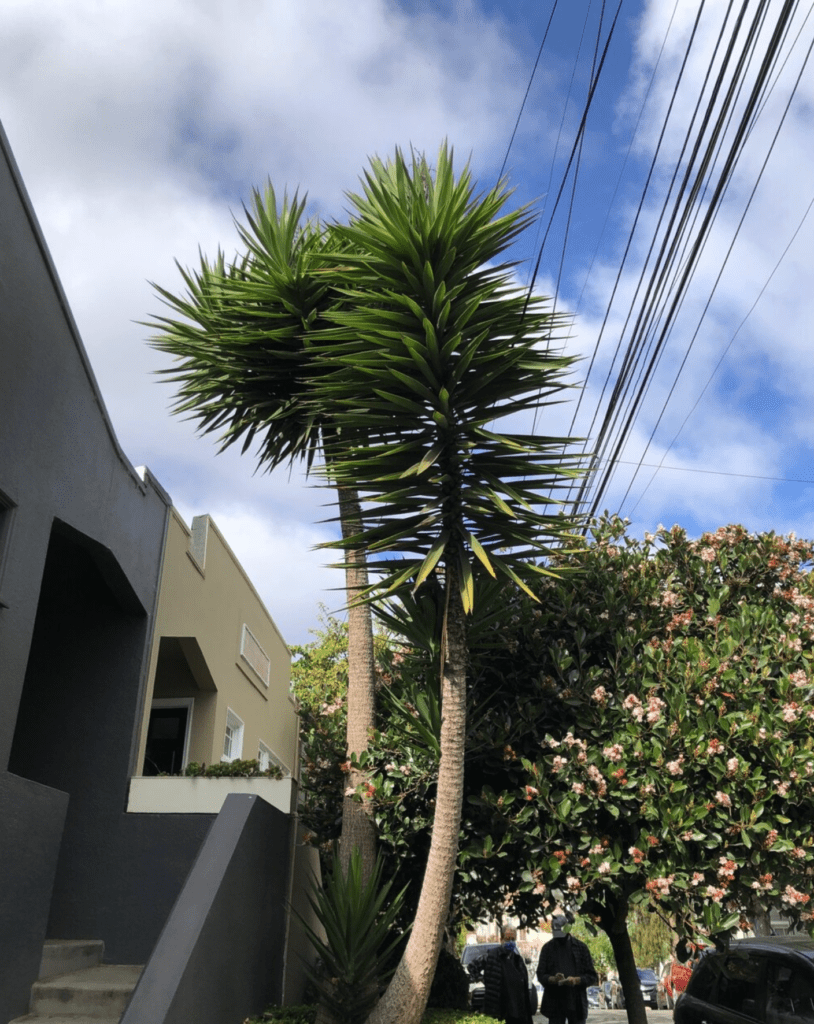
Sussex Street was once a cow path, a narrow, winding, rutted dirt byway. The walkers trooped up the narrow street, stopping at 53 Sussex.
“Wow,” said Kay Estey. “A stunning huge Yucca.”
The multi-trunked succulent is in the asparagus family and is widely grown in gardens where it needs space for thick trunks that have been likened to elephant feet.
“It’s a sun lover and somewhat drought tolerant,” said Estey. “In Central America, the flower petals and the tender stem tips are eaten and the flower is the national flower of El Salvador.”
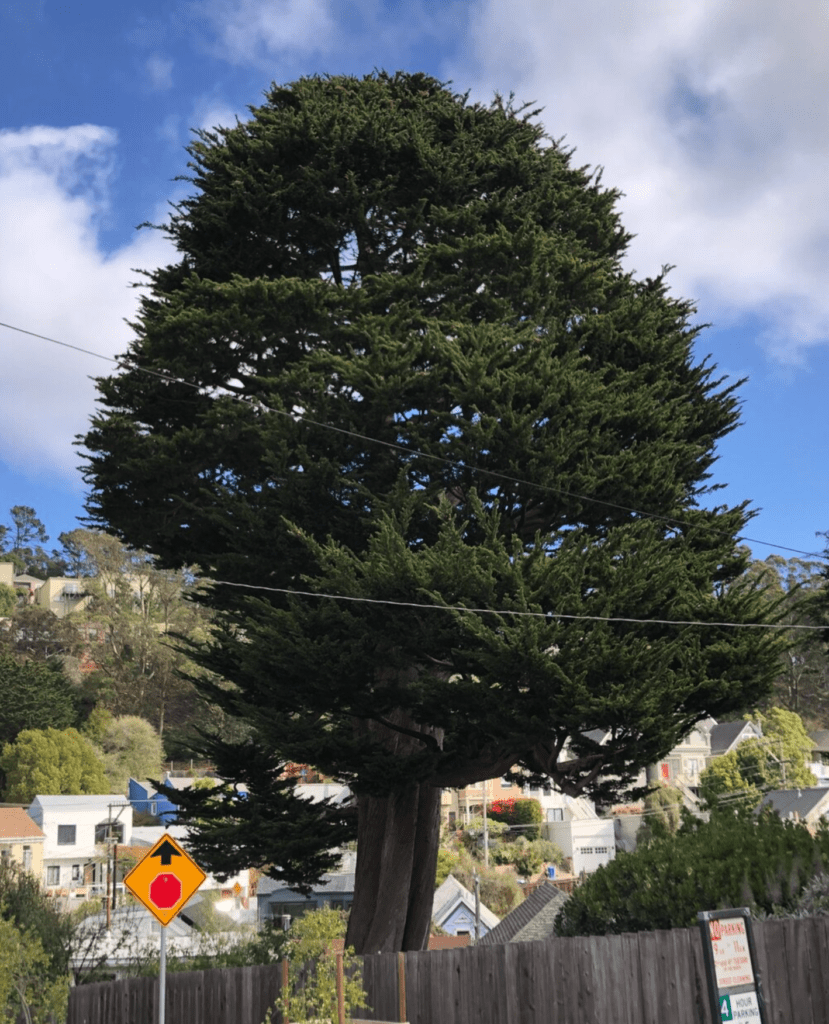
A block later they reached a tree that needed no introduction, as its ubiquity is unchallenged. Cloistered behind a fence at 155 Sussex — a fence that looked as if it begged a Tom Sawyer paint over — towered a Monterey cypress.
“This is one of San Francisco’s most common trees, dominating our parks,” said Sullivan. “It’s not usually a street tree because it gets so big. It’s native to very small areas that aren’t contiguous in central California.”
In fact, the stalwart cypress not only met one of Sullivan’s benchmarks about making a good photo, it also met another, the one about being outsized.
Older Montereys develop striking flat tops due to wind resistance and spreading contorted branches. The scale-like leaves grow in dense sprays that help trap water from the fog, which is important for the tree’s health and the health of the surrounding environment.
“The Monterey cypress, every tree,” said Sullivan, “is a carbon sink, absorbing carbon and helps in battling climate change and global warming.”
Estey, was thrilled to spot a Fern-leaf Catalina ironwood and native to the Channel Islands at 167 Sussex/
“It is unusual to see such a splendid version of the ironwood here and second it blooms heavily in summer when it is thickly covered in wooly white blooms. And the roots do not attack drains,” she continued.
From Sussex they descended Swiss Street, a homage to the real estate boosters who conflated Glen Park’s hills with the Swiss Alps. Swiss Street is a short block and if one has a choice it is preferable to challenge it by heading down, not up it. Once at the bottom the group turned right onto Surrey Street where Zoanne Nordstrom lives. There is something karmic about the tour circling Nordstrom’s house. She is a Glen Park legend, one of the three “Gum Tree Girls” who fought the transit planners who wanted to bulldoze Glen Canyon Park for a freeway. Along with Joan Seiwald and Geri Arkush, Nordstrom did battle with and defeated these automobile-centric mid-1960s know nothings.
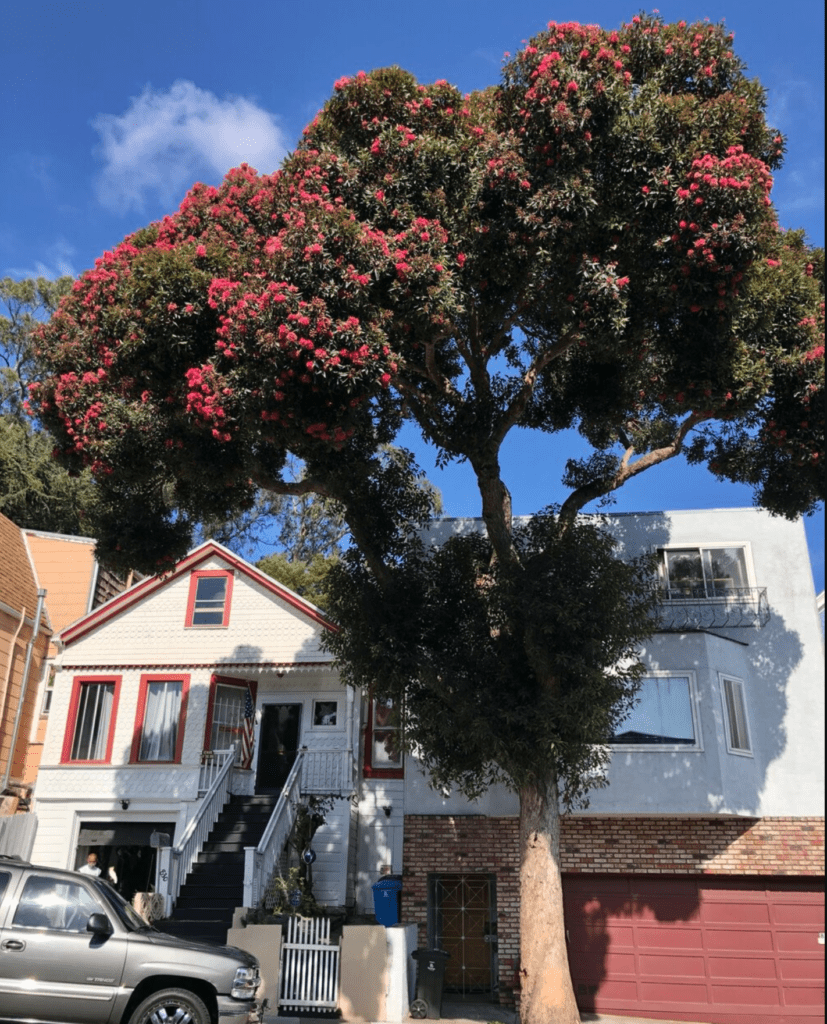
Now on Chenery Street the group headed back towards Diamond Street. The Greenway paralleled their walk, but they ignored it to concentrate on the trees rooting along the block. At 828 Chenery they stopped at a red flowering gum.
“This is a tree that I associate with Glen Park more than any other,” said Sullivan. “There are gorgeous specimens lining Bosworth on both sides of the street. The tree has spectacular red flowers and, interestingly, if you plant the seed of the tree, it doesn’t follow the color of the parent.”
A law of unintended consequence, though, is if you park a vehicle beneath one it soon becomes the recipient of a Rorschach blotch of red and sticky goo.
Nearly done now, the group stopped in front of 757-763 Chenery and studied a New Zealand Christmas tree. They’d clocked in at a little over two hours. It was past noon and Glen Park had been awake for several hours. Higher Grounds and Tyger’s were open for outside seating and brunch hungry residents, interested in a crepe or a short stack, queued up in front of the two popular eateries.
The Esteys said their so-longs to their companions and headed back to Conrad Street, where they’d turn right onto unpaved Poppy Lane. There they’d find 50 feet on their left a giant specimen of California buckeye.
“It’s a stunning tree,” said Kay.
We don’t need to travel to national parks to the balm of nature, simply going on a walking tour of Glen Park trees allows us to “breath in the beauty and mystery of our urban forests,” she said.
